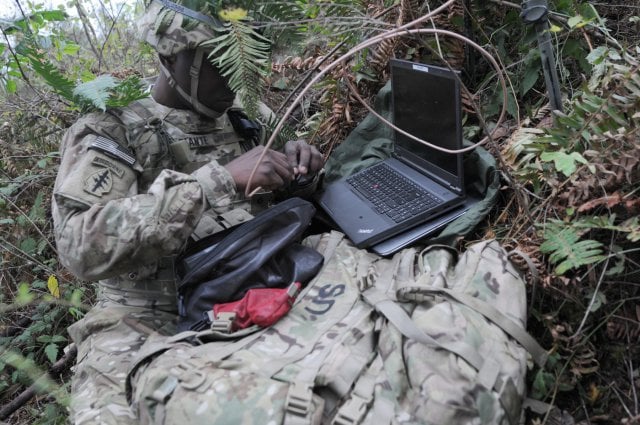By SYDNEY J. FREEDBERG JR.

WASHINGTON: The Army’s intelligence corps is embracing big data and artificial intelligence – but it has to balance that with preserving old school human skills at the same time, Lt. Gen. Laura Potter said Wednesday.
The intelligence force is furiously busy. It is creating new hybrid Intelligence/Electronic Warfare Battalions supporting Army divisions, meeting the unique intel needs of the new Multi-Domain Task Forces, and fielding the TITAN ground terminal and TLS signals intelligence/electronic warfare vehicle, said Potter, the service’s deputy chief of staff (G-2) for intelligence. But the impact of artificial intelligence is arguably the most fundamental change.
Given the overwhelming volume of both public and classified information that only AI can sort through, “we’re not going to be successful without it,” Potter said. But at the same time, she said, “it is not going to allow us to replace a human analyst.”
Even in a high-end conflict – with target data, jamming signals, and long-range missiles flying through the air every instant – you’re going to need someone who can step back from feeding the targeting machine and think about the big picture. That could well include thinking through how you’re going to stop the shooting.
There are “two dynamics,” Potter told an Association of the US Army webcast. “The Army intel force has to be ready to deliver quick sensor-to-shooter type intelligence,” she said. “But we also have to be able to deliver mature, deeply thought-through intelligence that an analyst has had time to deliberate on… [potentially] allowing that commander to get ahead of decisions that might contribute to de-escalation or ending a conflict.”
Likewise, in what the Pentagon calls the “competition” phase short of war, the intel corps has to constantly monitor adversary transmissions and positions to keep the commander informed. Yet, at the same time, it needs to build and sustain relationships with foreign partners and treaty allies that have cultural and linguistic expertise the US lacks. There’s no formal Military Occupational Specialty or Additional Skill Identifier in the personnel bureaucracy to point out who’ll be good at this kind of slow and steady work. But, Potter said, “you know when you have that right person, who’s going to be able to figure out the human dimension of it … and then be able to work that policy process.”
“We have learned a lot about how to do this well within the formal alliances,” she said: NATO, the Five Eyes, the bilateral treaty relationships in the Pacific. Outside those structures, she said, it takes assessing each potential partner case-by-case, figuring out how to share the appropriate data, and putting both “the [technical] architecture and the people doing that together, side by side on a regular basis.”
Even where artificial intelligence becomes essential, you need humans with a particular skillset to manage it. In particular, it’s crucial to remember that machine learning is not a one and done process, creating an algorithm that’s infallible for all time, but an ongoing and indeed constant evolution, where the AI algorithms repeatedly encounter new data and modify themselves to account for it. That’s a process human expertise must guide.
“We need a force that can train those algorithms,” Potter said, “so as adversary TTPs [Tactics, Techniques, & Procedures] change, they can train those algorithms to interpret it correctly.”
The Army will also need an intelligence force that can combine the best of human intuition and big data to figure out when a seemingly stable nation-state is about to take a nose dive into conflict. Under pressures from COVID to climate change, she said, “I think what we’re going to see in the out-years are countries that we assume are stable [instead] trend towards that fragility dynamic, if we’re not careful.”
No comments:
Post a Comment